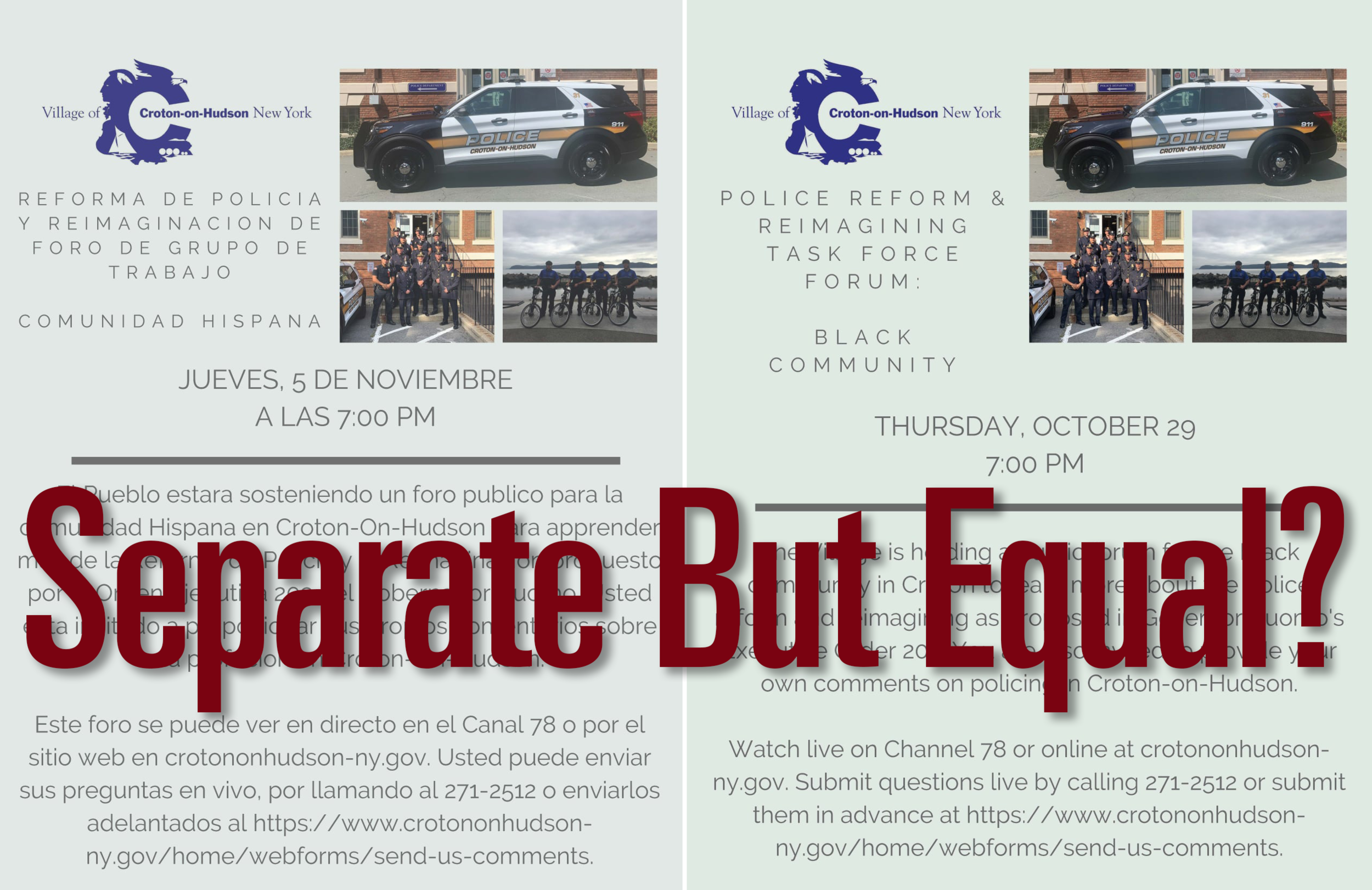I am perhaps the only person in Croton who thinks the code violations will be dismissed on Constitutional grounds by the Village Justice Court. Perhaps I am naïve in that hope, but rest assured that the federal court in White Plains has staff familiar with the First Amendment.
In 2021, the biggest impediment to protecting your right to free speech is the expense of going to court. That is where section 1983’s cousin (section 1988) comes into play.
Google “section 1988” and you will come across 1988(b) and 1988(c). Those two paragraphs mean that if you need to hire a lawyer to vindicate your rights under the First Amendment and the judge finds that Croton violated those rights, the court can require Croton to pay your attorney fees and expert fees.
As residents, we need to start to think about how to deal with the hostility of the Board of Trustees toward free speech.
This was always about more than getting a single MAGA flag down. Unlike in 1984, the power exercised to silence speech in Croton was never the power of “The Party.” Although our political leaders treat the municipal corporation of Croton as a subsidiary arm of “The Party,” the use of Code Enforcement and other sovereign powers means that this is bigger than “The Party.” It is because the black letter of village law is being enforced by municipal employees that Croton taxpayers need to be concerned.
It is unlikely that “The Party” is going to allow the presence of a MAGA flag in Croton. That leaves two possible outcomes.
The first and more likely outcome is a federal court deciding that Croton’s law is unconstitutional and that a resident has suffered damage. In that case, even if there is a nominal damage award the resident may have his attorney fees paid. Attorney fees can be large even if the damage award is small. In a 2015 Westchester County case, the damages awarded were $201 but the Village of Harrison also had to pay the resident’s attorney fees totaling $42,125 for 114 hours of work.
That was a section 1983 case decided very quickly (by a mechanism known as Summary Judgment); if the Village of Croton gets further along with their cases than the Village of Harrison did, the ultimate cost of failure can get astronomical.
And remember that Croton is likely going to be dragging a slew of us through the code enforcement process over the coming years. Let us say that five residents go all the way through federal court. That could easily be pushing a quarter of a million dollars if the residents win after a quick trip to court.
The second possible outcome is arguably worse. A lawsuit over the Croton code enforcement tickets could drag on for years: a 2007 Rockland County political sign case was decided (against the Village of Airmont) on Summary Judgment. It still took 30 months from initiation of litigation to Summary Judgment and another four months to wind up the loose ends.
While the Croton case is puttering about in federal court the Board of Trustees will have to be vigilant in making sure that there is no bias in enforcement: Croton cannot ticket MAGA flags but allow BLM flags and Pride flags. A facially neutral law can become fatally unconstitutional if enforced in a discriminatory manner.
At the end of the day, if the Village wins that is only the beginning. Suppression of speech will never stop.
There will always be another election coming down the pike. There will always be another cause about which residents feel passionate. Much as “The Party” yearns to silence dissent in Croton, our present form of government will not allow “Big Brother” or his fellow board members to do so. The Croton Village Code sign law is so permeated with unconstitutionality that this is going to repeat, albeit perhaps with a different section of the code.
At some point in the future we will be back at the starting point, gearing up for another visit to Justice Court and then onward to federal court.
I regret to bring up such a horrifying prospect to the readers of this fine publication, but—unpalatable as the thought is—it is possible that despite our best collective effort there will still be one or two Republicans living in Croton in 2024. What are we going to do if one of those knuckle-dragging Neanderthals gets it in their tiny brain that they have Constitutional rights?
What if one of them puts up—gasp—a flag?
For decades Croton has lived under a blatantly unconstitutional (and unenforced) village sign code. The constitutionality did seem to trouble Jim Staudt, the village attorney, while the rest of us just gave a collective eye roll. In ignoring Mr. Staudt, we left the door open for the situation we are in today.
Today, lifelong Croton residents cannot even wish everyone to “Bee Happy” without running afoul of the unconstitutional Croton village code. Black Lives Matter—except when Code Enforcement comes a-knockin’.
None of that is going to change if Croton prevails on the prospective MAGA litigation, because the moment that Croton code enforcement returns to benign neglect it is going to lose a future case.
Code enforcement in Croton never took place till after it was decided the MAGA flag had to come down. The then-Village Manager didn’t bother to do basic research and our Board of Trustees—often entertainingly incompetent—changed the wrong law! After some consternation, the Village found a different provision to attack the offending flag—the code is so convoluted that in Croton there is always another (unconstitutional) way to squelch speech.
Belatedly it dawned on the geniuses known as the Croton Board of Trustees that you can’t be so obvious in abusing government power, so the BLM and “Bee Happy” signs quickly came into the cross-hairs of the municipality. Expect that to continue in the years to come.
Efforts by “The Party” to crush diehard supporters of Bad Orange Man have already led other residents to consider self-censorship. Residents took to reading the village code to see if they could get ticketed for an American flag (no) or a BLM flag (maybe) or a Pride flag (yes).
The American flag is not immune from code enforcement. Whether you fly the American flag or burn it, you are engaging in First Amendment speech. For the current village code to allow an American flag but ticket a MAGA or BLM flag of equivalent size and placement is Constitutionally suspect. At minimum it means when Croton gets to federal court, cases will be evaluated under a “strict scrutiny” standard—get ready to pay out those 1983 damage awards.
My personal favorite was the member of the Croton tinfoil hat brigade (and I say that with love) who asserted to me that you could get ticketed for decorations in your living room. I made a dismissive reply, only to have to later apologize and concede the truth of the assertion.
The question arose because a local political leader has a BLM sign in the window of her home. It turns out that is prohibited in Croton by 230-44(P)(1)(c): “With respect to customary home occupations, no display of signage shall be visible from the street, except as set forth in Subsection P(1)(e) below.”
Next, we take that in conjunction with 230-44(O): “The combination of permanent and temporary signage applied to or placed within two feet of the interior of any given window shall be considered part of the signage in accordance with the provisions of this chapter.”
Finally we read the expansive definition of “sign” in 230-4 and yes it is true: if you put your kid’s plastic model airplane (if kids still make those) within two feet of your living room window, you theoretically could be fined in Village Justice Court.
To those who say this is taking the black letter of the Croton Village Code to an absurd conclusion, I say: It is the black letter of the code, and Code Enforcement is taking a serious risk if they pick and choose what types of speech to ticket (and yes, putting your kid’s model plane in the window can be considered speech).
No law—especially one with Constitutional implications—should be so constructed as to give unfettered discretion in enforcement. Particularly in a small community like Croton with a secretive and tight-knit political leadership not concerned about electoral opposition, this is dangerous. The decision to target the MAGA flag is a prime example of the danger, and won’t be the last such decision.
This decision was not made lightly by the Croton Board of Trustees. Any municipality targeting political speech is going to have extensive discussion with their attorney prior to commencement of enforcement. Municipal leaders know that such a matter is highly likely to end up in federal court.
Section 1983 is famous enough that any ticketed resident with a competent attorney will know that if the municipality loses it can be on the hook for a large amount of legal fees. Anybody at a senior level of government is familiar with 1983; while most common complaints involve law enforcement (which have qualified immunity), code enforcement and zoning officials are also familiar with the law.
No doubt Croton’s attorney (a specialist in municipal law) told the Board of Trustees about what happened to Airmont and Harrison, since those cases were decided in the very same courthouse that will hear the Croton cases. The 2007 Airmont case has been discussed here in Croton due to the involvement of a village resident, and incoming Assistant Village Manager Morzello probably is familiar with the 2015 Harrison case.
The Croton Board of Trustees (which is led by someone who is himself an attorney) would be aware of these basic facts. And yet…. They simply don’t care. Their arrogance and conflation of “The Party” with the municipal corporation of Croton mean that they will crush political opposition, no matter the long-term damage to the speech rights of Croton residents and no matter the financial cost.
A defining and enduring feature of our Croton Board of Trustees is an obstinate unwillingness to admit making a bad choice, let alone an actual mistake. Much like the Gouveia Park money pit or the nightly CPA light show visible from the Space Station, when it comes to silencing political speech our Board of Trustees ignores sound advice and common sense.
Free speech in Croton starts with taking a stand. In the final analysis, 42 U.S. Code section 1983 and section 1988 might help to cover some of the costs of the fight, and dissuade “The Party” in Croton from becoming “The Party” in Orwell’s 1984.
Free speech is worth the fight. Our Constitution is worth the fight.
Paul Steinberg



















